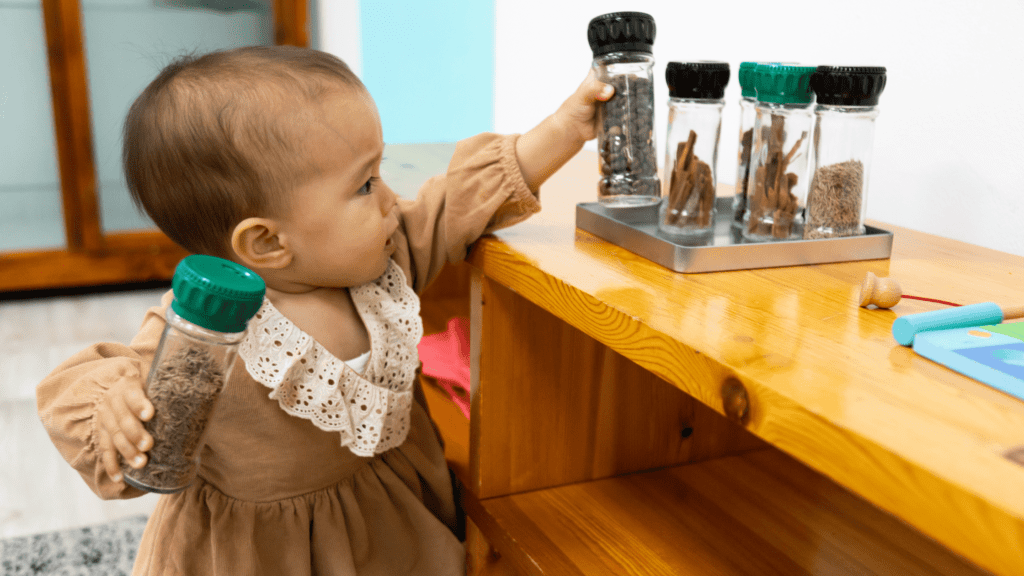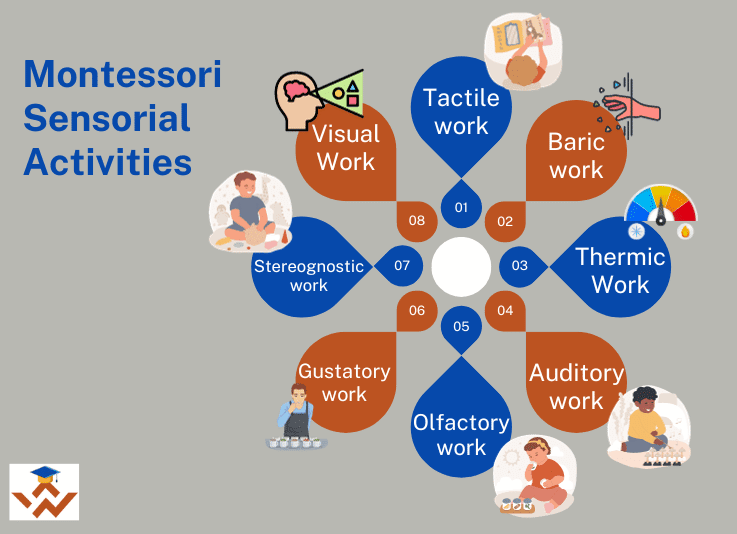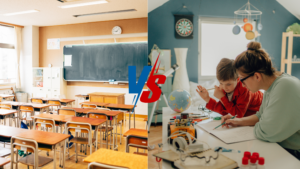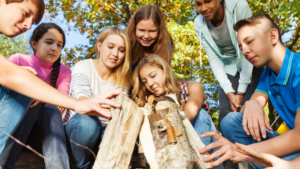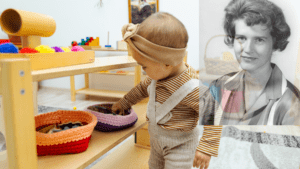From the moment children are born, they start to learn by using their senses to observe the world around them. This is why newborns respond to sound and touch. Sensory learning is the most natural way for children to learn problem-solving skills and develop their cognitive abilities.
“The senses are the instruments of knowledge. Through them, we come into contact with the world around us and learn about its properties. The more refined and developed our senses are, the more accurate and complete our knowledge will be…”(Maria Montessori, 1912)
Montessori schools are well known for their unique approach to early childhood education. In addition to focusing on academic subjects, Montessori places a strong emphasis on developing children’s sensory abilities. This is achieved through a variety of sensorial materials and activities that help children refine their senses and explore the world around them. In this article, we will take a closer look at Montessori’s sensorial activities and why they are so important for a child’s development.
What are Montessori Sensorial Activities?
Montessori sensorial activities are designed to help children develop and refine their senses. These activities are carefully crafted to provide children with experiences that stimulate their senses and build connections in their brains.
Maria Montessori developed a wide range of educational materials, known as “didactic apparatus,” to help children explore and learn about the world around them through their senses. These activities include exercises that help children identify and differentiate between textures, shapes, colors, sounds, and smells.
Montessori sensorial activities are also designed to help children develop their fine and gross motor skills. For example, activities that involve pouring, scooping, and transferring objects help children develop their hand-eye coordination and improve their dexterity.
Must Read: 20 Montessori Practical Life Activities that can be Setup at Home
Characteristics of Sensorial Activities
Montessori’s sensorial materials and activities possess specific characteristics that include being aesthetically pleasing, providing concrete representations of abstract concepts, having universal properties, being simple to complex, having isolated properties, and having control of error.
What makes Montessori Sensorial Materials Unique?
Montessori sensorial activities are designed to help children develop their:
- Discrimination skills: The ability to distinguish between different sensory stimuli, such as size, shape, color, and texture.
- Comparison skills: The ability to compare different sensory stimuli and identify similarities and differences.
- Sequencing skills: The ability to order sensory stimuli in a logical sequence.
- Classification skills: The ability to group sensory stimuli based on shared characteristics.
- Spatial reasoning skills: The ability to visualize and understand spatial relationships.
Montessori sensorial activities are typically presented in a sequence that follows the child’s natural development. For example, activities that focus on the sense of touch are often presented before activities that focus on the sense of sight. This allows children to build a foundation of skills in one area before moving on to more complex skills in another area.
Montessori sensorial activities are also designed to be self-correcting. This means that children can learn independently, without the help of an adult. The materials are designed in such a way that children can easily see if they have made a mistake. This helps children to develop a sense of self-confidence and a love of learning.
Why are Montessori Sensorial Activities Important?
Montessori sensorial activities help children develop their
- Senses, which are crucial for their overall development. The senses are the foundation for all learning, and by developing their senses, children are better equipped to learn and engage with the world around them.
- Concentration, coordination, and independence: By engaging in activities that require focus and attention to detail, children learn how to concentrate and develop their concentration skills. Additionally, many sensorial activities are designed to be completed independently, which helps children develop their independence and confidence.
- Creativity and imagination: By exploring different textures, colors, and shapes, children are encouraged to think creatively and use their imagination to create new experiences and ideas.
Sensorial Activities and Montessori
“The first three years of life are the most important for sensorial development.” – Dr. Jean Piaget
In the Montessori curriculum, sensorial activities are incorporated into all areas of learning. These activities are set up in a prepared environment to allow children to safely explore and learn about their surroundings using their senses. These activities provide children with rich sensory experiences that promote structured growth and development, making connections in the brain and improving memory and cognitive ability.
At what age sensorial activities are introduced in Montessori
Generally, a child’s senses are fully developed by age 7-8 years. Therefore, Sensorial activities are introduced to children in Montessori education around the age of 3-6 years old i.e. in the Primary level curriculum.
Also Check: Montessori Criticism Debunked: The Top 10
What are the List of Sensorial Activities in Montessori Curriculum?
Dr. Maria Montessori during her research in 1912, divided a child’s sensorial learning into eight categories/ work:
1. Visual work:
The purpose of visual work in Montessori sensorial activities is to help children categorize and distinguish similarities and differences in objects using their sense of sight. It covers dimension (size, length, width, and breadth of objects), color (color awareness), and form (shape awareness). The activities included in this category aim to develop children’s ability to identify and differentiate between these characteristics.
- Dimension:
Lessons in the size category help children differentiate between big and small objects, as well as heavy and light objects. The activities in these lessons prepare children for math by teaching them how to count, add numbers, and measure things. As they move both horizontally and vertically, they learn skills that will help them learn to read and write. These activities also help children develop coordination, attention, organization, and independence.
-
- Pink Tower,
- Brown Stairs,
- Knobbed Cylinders
- Knobless Cylinders,
- Red Rods
-
Color:
Activities under this category help children focus on developing chromatic senses as it enables them to recognize similarities and differences between primary colors, secondary colors, and grading.
-
- Primary Color Box
- Primary color Box 2,
- Secondary Color Wheel,
- Value (Black, White, Gray) Color Tablets,
- Mixing Black and White,
- Color Gradation Color Box 3
-
Form:
Engaging in below mentioned geometric activities can help children improve their ability to recognize differences and similarities in shape and form. As they learn about different figures, they can also develop the capability to observe the progression from concrete to more abstract forms.
-
- Geometric Solids
- Binomial Cubes
- Trinomial Cubes
- Constructive Triangles
- Blue Triangles Box
- Rectangular Box
- Triangle Box
- Large Hexagon Box
- Small Hexagon Box
2. Tactile work:
Montessori sensorial activities that involve tactile work helps children develop their sense of touch, so they can recognize the difference between coarse and fine textures. These activities aim to improve children’s ability to identify and differentiate between different textures.
- Mystery Bags or Stereognostic Bags
- Matching Objects Mystery Bags
- Rough and Smooth Touch Boards
- Rough and Smooth Touch Tablets
- Fabric Box
3. Baric Work:
The goals of baric work are to help children understand pressure and weight and to develop critical thinking skills. Activities for baric work include baric tablets.
4. Thermic Work:
Thermic work aims to help children distinguish between temperatures and develop their sense of temperature. This includes activities related to hot and cold, warm and cool, and the relationship of temperature to the child’s own body. Activities include
- Thermic Bottles,
- Thermic Tablets
5. Auditory work:
The auditory work in Montessori sensorial activities is designed to help children develop their sense of hearing and perception of sound. The activities aim to help children to differentiate between distinct sounds and enhance their ability to notice variations in sound. The activities included in this program are carefully crafted to provide children with experiences that stimulate their auditory senses and build connections in their brains. List of activities under auditory work are:
- Montessori bells, and
- Sound cylinders.
6. Olfactory work:
Olfactory work in Montessori aims to develop a child’s sense of smell and ability to differentiate between distinct smells. This is achieved through activities such as smelling bottles. However, olfactory work in Montessori goes beyond simply smelling different scents. It can also help children develop their vocabulary and language skills, as they learn to describe the scents they are experiencing.
7. Gustatory work:
Gustatory work activities are designed to enable children to explore their sense of taste and distinguish between different flavors, such as sour, bitter, and sweet. By engaging in these exercises, children can develop the ability to differentiate between a variety of foods and tastes. The activities involved in this category include tasting different food items and using descriptive language to identify their taste.
- Tasting food prepared by practical life activities, such as grating, slicing, peeling, slicing, and more
- Tasting bottles.
8. Stereognostic work:
Stereognosis is the ability to recognize objects by touch. It’s also called the sixth sense, muscle memory, or tactile gnosis. To improve stereognosis, children can practice using their sense of touch. This helps them recognize objects without relying on sight, sound, smell, or taste. Activities that may help develop stereognosis include:
- Mystery bags or stereognostic bags
- Painted and sandpaper globes,
Conclusion
“The senses are a kind of reason. Taste, touch, and smell, hearing and seeing, are not merely a means to sensation, enjoyable or otherwise, but they are also a means to knowledge – and are, indeed, your only actual means to knowledge.” – St. Thomas Aquinas
The Montessori curriculum includes a variety of sensorial activities that focus on descriptive language, recognition, observation, categorization, and pattern matching. These activities are didactic and help children develop more than just their senses. They also foster independence and confidence. Thus, Montessori sensorial materials facilitate the process of discovering and experiencing knowledge.
FAQs on Sensorial Activities
- What is the aim of sensorial activities?
The aim of sensorial education is to develop and refine a child’s sensory perceptions, including touch, sight, hearing, taste, and smell. This educational approach, often associated with the Montessori method, emphasizes hands-on experiences and activities that engage the senses.
- What are the three main activities a child can perform with sensorial materials?
Children exploring sensorial materials undergo three essential activities: discovering sensory traits, discerning differences, and refining skills through repetition. This dynamic process nurtures holistic sensory and cognitive development.
- What are the benefits of sensorial education?
Sensorial education fosters enhanced sensory perception, cognitive development, and attention to detail in children. Through activities like exploration, discrimination, and refinement with sensory materials, it cultivates a strong foundation for learning, encourages independent thinking, and promotes a holistic approach to understanding the surrounding environment.

